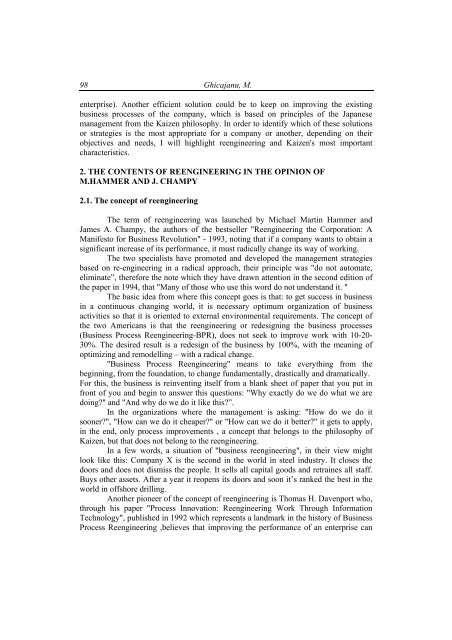annals of the university of petroÅani â¼ economics â¼ vol. xi - part i ...
annals of the university of petroÅani â¼ economics â¼ vol. xi - part i ...
annals of the university of petroÅani â¼ economics â¼ vol. xi - part i ...
Create successful ePaper yourself
Turn your PDF publications into a flip-book with our unique Google optimized e-Paper software.
98 Ghicajanu, M.<br />
enterprise). Ano<strong>the</strong>r efficient solution could be to keep on improving <strong>the</strong> e<strong>xi</strong>sting<br />
business processes <strong>of</strong> <strong>the</strong> company, which is based on principles <strong>of</strong> <strong>the</strong> Japanese<br />
management from <strong>the</strong> Kaizen philosophy. In order to identify which <strong>of</strong> <strong>the</strong>se solutions<br />
or strategies is <strong>the</strong> most appropriate for a company or ano<strong>the</strong>r, depending on <strong>the</strong>ir<br />
objectives and needs, I will highlight reengineering and Kaizen's most important<br />
characteristics.<br />
2. THE CONTENTS OF REENGINEERING IN THE OPINION OF<br />
M.HAMMER AND J. CHAMPY<br />
2.1. The concept <strong>of</strong> reengineering<br />
The term <strong>of</strong> reengineering was launched by Michael Martin Hammer and<br />
James A. Champy, <strong>the</strong> authors <strong>of</strong> <strong>the</strong> bestseller "Reengineering <strong>the</strong> Corporation: A<br />
Manifesto for Business Re<strong>vol</strong>ution" - 1993, noting that if a company wants to obtain a<br />
significant increase <strong>of</strong> its performance, it must radically change its way <strong>of</strong> working.<br />
The two specialists have promoted and developed <strong>the</strong> management strategies<br />
based on re-engineering in a radical approach, <strong>the</strong>ir principle was "do not automate,<br />
eliminate”, <strong>the</strong>refore <strong>the</strong> note which <strong>the</strong>y have drawn attention in <strong>the</strong> second edition <strong>of</strong><br />
<strong>the</strong> paper in 1994, that "Many <strong>of</strong> those who use this word do not understand it. "<br />
The basic idea from where this concept goes is that: to get success in business<br />
in a continuous changing world, it is necessary optimum organization <strong>of</strong> business<br />
activities so that it is oriented to external environmental requirements. The concept <strong>of</strong><br />
<strong>the</strong> two Americans is that <strong>the</strong> reengineering or redesigning <strong>the</strong> business processes<br />
(Business Process Reengineering-BPR), does not seek to improve work with 10-20-<br />
30%. The desired result is a redesign <strong>of</strong> <strong>the</strong> business by 100%, with <strong>the</strong> meaning <strong>of</strong><br />
optimizing and remodelling – with a radical change.<br />
"Business Process Reengineering" means to take everything from <strong>the</strong><br />
beginning, from <strong>the</strong> foundation, to change fundamentally, drastically and dramatically.<br />
For this, <strong>the</strong> business is reinventing itself from a blank sheet <strong>of</strong> paper that you put in<br />
front <strong>of</strong> you and begin to answer this questions: "Why exactly do we do what we are<br />
doing" and "And why do we do it like this”.<br />
In <strong>the</strong> organizations where <strong>the</strong> management is asking: "How do we do it<br />
sooner", "How can we do it cheaper" or "How can we do it better" it gets to apply,<br />
in <strong>the</strong> end, only process improvements , a concept that belongs to <strong>the</strong> philosophy <strong>of</strong><br />
Kaizen, but that does not belong to <strong>the</strong> reengineering.<br />
In a few words, a situation <strong>of</strong> "business reengineering", in <strong>the</strong>ir view might<br />
look like this: Company X is <strong>the</strong> second in <strong>the</strong> world in steel industry. It closes <strong>the</strong><br />
doors and does not dismiss <strong>the</strong> people. It sells all capital goods and retraines all staff.<br />
Buys o<strong>the</strong>r assets. After a year it reopens its doors and soon it’s ranked <strong>the</strong> best in <strong>the</strong><br />
world in <strong>of</strong>fshore drilling.<br />
Ano<strong>the</strong>r pioneer <strong>of</strong> <strong>the</strong> concept <strong>of</strong> reengineering is Thomas H. Davenport who,<br />
through his paper "Process Innovation: Reengineering Work Through Information<br />
Technology", published in 1992 which represents a landmark in <strong>the</strong> history <strong>of</strong> Business<br />
Process Reengineering ,believes that improving <strong>the</strong> performance <strong>of</strong> an enterprise can

















